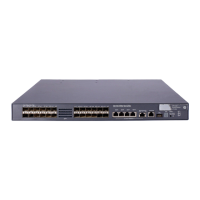80
Configuration example
# Specify that the device use IEEE 802.1d-1998 to calculate the default path costs of its ports.
<Sysname> system-view
[Sysname] stp pathcost-standard dot1d-1998
# Set the path cost of GigabitEthernet 1/0/3 on MSTI 2 to 200.
<Sysname> system-view
[Sysname] interface gigabitethernet 1/0/3
[Sysname-GigabitEthernet1/0/3] stp instance 2 cost 200
Configuring port priority
The priority of a port is an important factor in determining whether the port can be elected as the root
port of a device. If all other conditions are the same, the port with the highest priority will be elected as
the root port.
On an MSTP-enabled device, a port can have different priorities in different MSTIs, and the same port
can play different roles in different MSTIs, so that data of different VLANs can be propagated along
different physical paths, implementing per-VLAN load balancing. You can set port priority values based
on the actual networking requirements.
Make this configuration on the leaf nodes only.
To configure the priority of a port or a group of ports:
To do... Use the command... Remarks
1. Enter system view
system-view —
Enter Ethernet interface
view or Layer 2
aggregate interface view
interface interface-type
interface-number
2. Enter
interface
view or port
group view
Enter port group view
port-group manual port-
group-name
Required.
Use either command.
3. Configure the port priority
stp [ instance instance-id ]
port priority priority
Required.
128 for all ports by default.
When the priority of a port is changed, MSTP will re-calculate the role of the port and initiate a state
transition.
A lower priority value indicates a higher priority. If you configure the same priority value for all ports on a
device, the specific priority of a port depends on the index number of the port. A lower index number
means a higher priority. Changing the priority of a port triggers a new spanning tree calculation process.
Configuring the link type of ports
A point-to-point link is a link directly connecting two devices. If the two ports across a point-to-point link
are root ports or designated ports, the ports can rapidly transition to the forwarding state after a
proposal-agreement handshake process.
Make this configuration on the root bridge and on the leaf nodes separately.
To configure the link type of a port or a group of ports:

